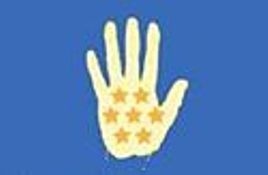
Last modified: 2019-08-06 by bruce berry
Keywords: congo | loango |
Links: FOTW homepage |
search |
disclaimer and copyright |
write us |
mirrors
 Image sent by Ivan Sache, 01 Nov 2009
Image sent by Ivan Sache, 01 Nov 2009
See also:
The Kingdom of Loango, also known as the Kingdom of Lw„„gu, was a pre-colonial African state from approximately the 15th to the 19th Centuries in what is now the Republic of Congo. At its height in the seventeenth century the country stretched from Cape St Catherine in the north to almost the mouth of the Congo River. Its inhabitants were a branch of the Bakongo. Missionaries who visited the Loango coast at the end of the nineteenth century often called the people of Loango Bafiote, and their language Fiote. Their ethnic name today is usually given as Vili or Bavili.
The Provinces of Loango, Ngoyo and Kagongo seceded very early
from the Kingdom of Kongo to form independent kingdoms. In the 11th century, the
Bouvandji party, supported by warriors and blacksmiths, ruled a state called
Loandjili (from "loa", the political power, and "ndjili", the squirrel as the
symbol of power). The Bouvandji were eventually expelled and the Kingdom
of Loango emerged in the 13th century. "Ngo" means "panther", Loango being
therefore "the Royal power with the panther as its totem".
The Kingdom of Loango is now made of seven provinces, each of them being ran by a
Prince-Governor ("fumu") representing the King's authority:
- Me MíPili; capital, Bwali; also the capital of the kingdom;
- Me Tchilunge; the biggest of the provinces, ruled by a governor called
Matchilunge;
- Me Tchi Lwandjili (aka M'Banda); named after the ancient capital of the
Bouvandji party;
- Nga Kanu;
- Me Yombi;
- Me NíKugni-MíBanza (aka Diangala or Grand Niari);
- Me NíGo Kwangu (aka Setekana).
Ivan Sache, 01 Nov 2009
The modern flag of the Kingdom of Loango has a light blue field in the centre of
which is a open hand containing seven yellow stars in the palm.
The historical seven provinces are represented on the kingdom's coat of arms by a hand palm
holding seven stars ("Li kande likoko li simbe mbote sambwali", the hand palm
holds seven stars).
The stars have also an esoteric meaning linked to the power: the Royal hand
rules the seven provinces, each of them representing a vital organ of the
sovereign:
- two stars represent the two eyes of the sovereign, who is constantly watching
his people;
- two stars represent the two ears of the sovereign, who is paying attention to
the requests of his councillors and of his people;
- two stars represent the two nostrils of the sovereign, who is very concerned
by the problems of his people. Powered with a very subtle sixth sense, the
sovereign is able to establish a link between the present and the future;
- a figure [I guess, a star] represents the mouth of the sovereign, used to
educate the people and deliver an impartial justice.
Succession to the throne is quite complex in Loango because of succession wars
involving different tribes. Elected on 29 August 1996, King Moe Taty I had his
coronation delayed until 13 November 2000. He passed away on 11 August 2007 but
the "main crown prince", his nephew MoŽ FranÁois Fouti-Loemba, has not
yet been
crowned.
Further detailed information on the Kingdom of Loango is available on its
official website.
Ivan Sache, 01 Nov 2009
The Kingdom has a new king. Moe Makosso VI was invested on 29 August
2009 at Diosso as the 17th king of the Loango.
Chrystian Kretowicz, 01 Nov 2009
Flags of the Loango can be seen
here and here.
Fabien Antoine, 16 April 2012